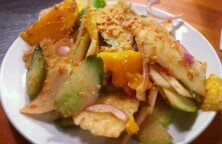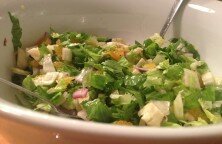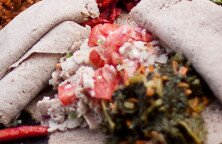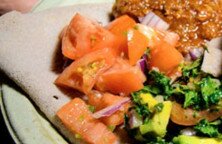Egyptian Koshary
2012-10-29- Cuisine: Egyptian
- Course: Main Course
- Servings : 6-8
Koshary is truly an Egyptian dish, if not in origin, then at least in the fervor with which Egyptians of all walks, from presidents to day laborers, have embraced it and carried on the tradition.
Surprisingly, you won’t find it in many Egyptian restaurants outside of Egypt, and there is perhaps a reason; made correctly, koshary is an eight-pot (!) wonder and keeping many of those ingredients fresh and hot is a challenge. Koshary restaurants generally serve only one thing all day long and they serve a lot of it. The menu consists of half a dozen size gradations of koshary, ranging from a normal dinner portion to “The Superman.” Instead of dessert, you can ask for a “topper-off-er,” or an extra scoop of koshary, to fill you up.
Koshary is fast food – plates or to-go boxes can usually be assembled in under a minute, exploiting assembly line efficiencies more common to high tech manufacturing – but it’s not greasy or bland. Just rice, pasta, chick peas, lentils, crispy onions, and tomato sauce finished off with hot sauce and a garlic vinegar. The secret to koshary is in the execution – each ingredient cooked to the perfect consistency (some tender, some crunchy) and just the right balance of sweet, sour, hot and pungent, a perfectly formed pile of food.
So onto the cooking task! How do you cook an eight-pot meal? Luckily, some components (lentils, hot sauce, tomato sauce, garlic vinegar) can be prepared the day before when you put the chickpeas in to soak. Either way, you’re investing in koshary production. So, make a lot and invite your friends.
Ingredients
- 2 cups small macaroni-type elbow pasta (can use whole wheat)
- 2 cups tubetti-type pasta (we used rigatoni, can use whole wheat)
- ½ cup broken vermicelli
- 2 cups short-grained white rice, washed (Doha is best)
- 2 cups dry chickpeas, washed and soaked overnight (or from a can, washed and drained)
- 2 cups brown lentils, washed
- 4-6 large tomatoes or 1 28-oz can whole peeled tomatoes, strained
- 2 large red onions
- 3 TBSP tomato paste
- ~ 2 to 3 heads of garlic
- 5 hot red peppers of any variety (we used Fresnos)
- 1/4 cup of vinegar (we used white vinegar)
- 2 limes
- flour (for coating onions)
- vegetable oil for frying
- olive oil
Method
Step 1
Chickpeas: If using dry chickpeas, soak overnight then boil until tender, 1.5-2 hours (optionally with a clove or two of garlic and bay leaf). Rinse and drain. If using canned chickpeas, drain, rinse and set aside.
Step 2
Lentils: Boil lentils until tender (or add boiling water, wrap pot in a towel and cover for several hours). Strain resulting broth (mixing with additional water if necessary to create enough) and set aside. This will be the base for the garlic vinegar. Rinse and strain remainder of lentils.
Step 3
Garlic-Vinegar Sauce: Option 1: Use a cup or two of the broth from the lentils and add finely chopped or grated garlic, salt to taste. Add fresh squeezed lime or white vinegar until you have a tart liquid. The brown lentil broth will naturally settle, so this sauce needs to be mixed right before being added to the plate. Option 2: Finely mince a head of garlic and sauté in olive oil until tender and fragrant, about 4-5 minutes. Add a cup or two of white vinegar, bring to a simmer and then remove from heat.
Step 4
Tomato Sauce: Blanch tomatoes and when cool chop into large pieces. Heat about 5 cloves (or much more) of minced garlic in olive oil for a few minutes (just before they started to turn brown). Add the tomatoes and crush in the pan (alternatively, you could use a food mill or start with canned strained tomatoes) with 1 to 2 tablespoons of tomato paste. Cook the tomatoes (they will change color and thicken, about 10-20 minutes). Add a little water and vinegar, enough to make the sauce slightly tart, and bring to a boil. As soon as the sauce has boiled, set it aside.
Step 5
Onion: Slice onion lengthwise into fine strips, taking care to ensure as consistent a size as possible. Option 1: Coat onion slices lightly with flour and a little salt and deep fry in vegetable oil until deep golden brown. Option 2: Heat in a dry skillet to remove some of the moisture first then fry in oil. When the onion comes out of the oil, toss with a little salt and dry in a strainer or on a paper towel.
Step 6
Hot Sauce: This is typically a very thin hot sauce but one that packs a lot of punch. Option 1: Boil hot peppers until about half cooked. Then blend in a food processor with vinegar. Option 2: In a food processor or blender, add red chili peppers, a couple of tablespoons of olive oil, several cloves (or more) of garlic, a splash of vinegar, enough tomato paste to take the edge off, salt to taste, enough water to blend easily, and any other spices you like (cumin, fresh parsley, coriander etc.). Bring to a boil and then simmer until cooked.
Step 7
Rice: Fry the broken vermicelli pieces in a little vegetable oil until they turn light brown, stirring constantly, then add rice to oil and heat until either the vermicelli is medium brown or the rice starts to become translucent, whichever happens first. Add enough water to cook the rice but not make it soggy, bring to a boil, cover and simmer for 15-20 minutes according to the directions.
Step 8
Pasta: Cook both types of pasta according to the directions. If cooking times are different, add the second to the salted boiling water so that both finish at the same time.
Average Member Rating
(4 / 5)
1 people rated this recipe















